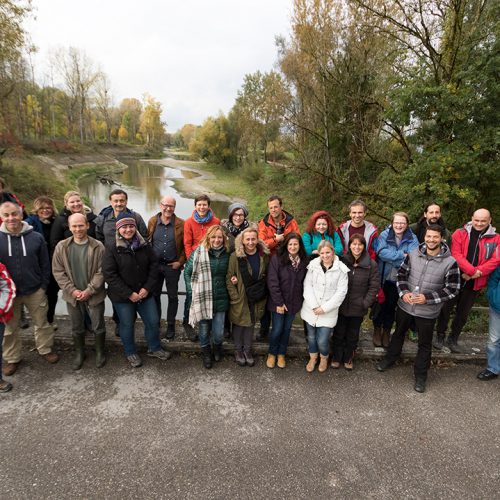Hírek
Austria shares 20 years of river restoration experience
Drava LIFE excursion to Austria’s restoration sites
Riverine ecosystems are amongst the most endangered ecosystems in Europe and the Drava River is no exception. As many as 22 hydropower plants in Austria, Slovenia and Croatia crosscut the Drava and left only a short free-flowing stretch of the river in Croatia. The aim of the “DRAVA LIFE Project – integrated river management” is to restore the river characteristics and degraded ecosystems to achieve the objectives of the EU Water Framework Directive and Natura 2000. In the course of the project, project partners will restore and create 1,000 metres of dynamic river banks, 13 hectares of new dynamic river zones with gravel, sand and clay banks, 14.5 kilometres of side-arms and improve 300 hectares of floodplain forests.
Last week, partners in the DRAVA LIFE project visited the upper flow of the Austrian Danube River, where they had the possibility to have a look at experience and results of 20 years implementing EU LIFE river restoration projects. Due to the construction of hydroelectric power plants and maintenance of waterways, ecosystems along the Danube have been degraded, but the continuous restoration efforts have significantly improved the ecological status of the river its tributaries in Austria. Furthermore, the trend of declining fish and birds species could be stopped, the return of endemic species to the area was enabled and flood protection improved. The latter is also the goal of the LIFE project in Croatia.
Representatives of Croatian Waters, the Ministry of Environment and Energy, Green Osijek, public institutions for management of protected natural values along the Drava River and WWF visited five locations of the EU LIFE+ projects along the Danube. Through a cooperation of local communities, NGOs, the energy sector and the agency for waterways about 100 km of the Danube flow could be restored, as well as old side-arms, oxbows and gravel islands. Furthermore, tributaries and floodplains could be re-connected with the main river. These actions have repaired the damage caused by hydropower plants and managed to increase the biodiversity of the area, which in turn increases the value of the region as a holiday destination.
On the first day of the excursion, partners visited a large restoration project site on the Traisen River, which was previously cut off from its floodplains and the Danube because of the construction of the hydropower plant Altenwörth. The project created a 12 km long, completely new river bed, through which the Traisen was re-connected with its floodplains and the Danube. On the second day, the Wachau valley was visited. In the area, which is known for its wines and apricot products, several side arms and natural banks were restored, new river islands were created and gravel management was improved. On the last day, the participants visited the longest European fish pass, with a length of 14.2 km. The fish pass is vital for migratory fish species, as it allows them to migrate past the Danube hydropower dam at Ottensheim-Wilhering. After two month of finishing the fish pass, monitoring results show that it is used by a growing number of fish not only for migration, but also for reproduction.
“Next to the obvious improvements of ecological and biological conditions along the rivers, local communities and sectors of navigation, tourism, water management and energy have the greatest benefits from these demanding river restoration works. A multidisciplinary approach and involvement of all relevant stakeholders and competent state associations was developed and it provided a high level of mutual trust. This has resulted in a substantial reduction of administrative procedures, such as obtaining location and building permits and impact assessment studies. This has in turn led to the successful implementation of a series of projects over the last 20 years,” said Zdenko Kereša, project manager at Croatian Waters.
“The exchange of experiences between LIFE projects is an integral part of project activities within the LIFE programme in Europe. In addition to connecting many experts, we also learn about examples of good practice, which can be applied, not only during the project implementations, but also in the daily work of the institutions involved. The visit to LIFE project sites in Austria is very beneficial to our project, we learned about the activities that we will carry out over the course of the next four years and we learned about a number of new possibilities to improve Drava’s ecosystems,” said Branka Španiček from WWF Adria .



